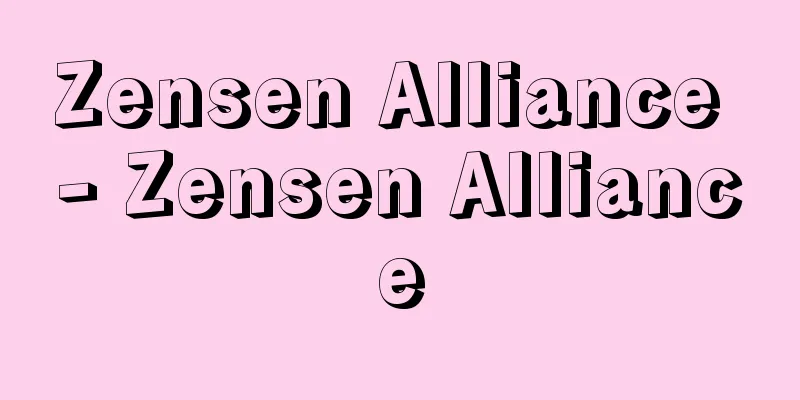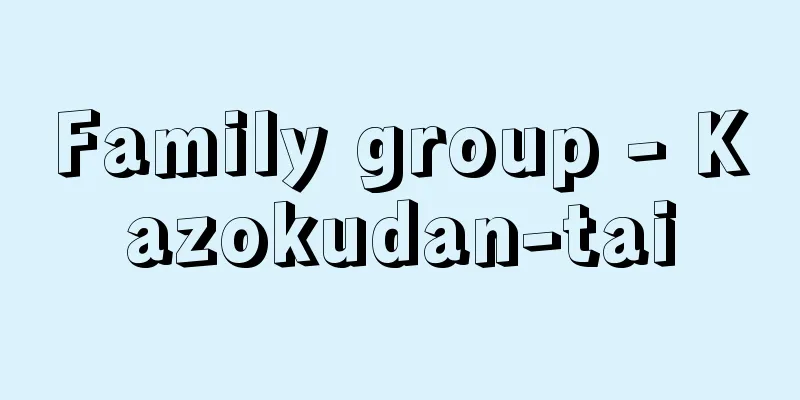Zensen Alliance - Zensen Alliance

|
A national labor union whose members were workers in the textile and distribution industries. An affiliate of the Japanese Trade Union Confederation (RENGO). On July 31, 1946, textile workers were organized by company and the National Federation of Textile Industry Workers' Unions (Zensen Domei) was formed as a unit union. Later, as the organization of distribution-related industries progressed, the union was renamed Zensen Domei at its 30th convention in September 1974. Furthermore, in September 2002, three industrial unions, namely Zensen Domei, which organized textile and distribution-related industries, the Japan Chemical, Service and General Workers' Union Federation (CSG Federation), which organized chemical, pharmaceutical and service-related industries, and the Japan Textile Life Industry Workers' Union Federation (Seniseikatsu Roren), which organized local textile industries, merged to form the National Federation of Textile, Chemical, Food, Distribution and Service General Workers' Unions (UI Zensen Domei). As a result, UI Zensen Domei became the largest union affiliated with RENGO. Number of union members: 1,093,329 (March 2011). Zensen Domei was a member of the Japanese Trade Union Confederation (SODEI) at the time of its formation, but when the General Council of Japanese Trade Unions (SOHYO) was formed in 1950, it withdrew from SODEI and joined it. In 1953, criticizing SOHYO's leftward shift, Zensen Domei withdrew from SODEI and formed the All Japan Trade Union Congress (Zenro Kaigi) together with SODEI and the All Japan Seamen's Union (Seamen's Union), and joined the All Japan Trade Union Confederation (Dōmei) when it was formed in November 1964 following the dissolution of Zenro Kaigi. Zensen Domei impressed the public with its strength in the 1954 Omi Silk Thread Strike (known as the "human rights strike"), the 1957 struggle for shorter working hours, and the 1970s wage struggle, and it represented the right wing of the Japanese labor movement and developed its movement with the ideals of labor unionism and industrial democracy. However, in the late 1960s, the textile industry, a traditional industry in Japan, was exposed to international competition, and textile capital diversified its operations and made progress in the distribution sector, such as supermarkets, with success. As a result, the number of members under the All Japan Textile Federation's Industrial Association increased to include not only textile workers but also workers in other occupations, and the old name of the union no longer reflected the reality, so it was changed to Zensen Domei. In 1993, the Distribution Section accounted for 250,000 of the total union members, which was about 590,000. It has always played a leading role in the private sector-led movement for unifying the labor front in the 1980s. While Zensen Domei is organized on a company-by-company basis, in 1995 it was organized into seven sections: General Textiles, General Chemical and Textiles, Clothing Industry, Distribution and Services, Specialty Stores, Food Services, and Local Industries, and branches were set up in each prefecture to allow for closer activities with affiliated unions. These sections have the characteristics of general labor unions, not limiting their organization to a specific industry. As mentioned above, in September 2002, Zensen Domei, CSG Rengo, and Textile and Consumer Goods Union Union merged to form UI Zensen Domei, and since then, as the name of the organization suggests, it has further strengthened its character as a general labor union. Furthermore, it has been proactive in organizing not only regular employees but also non-regular employees, and has achieved great results. Internationally, we are affiliated with the International Textile, Clothing and Leather Workers' Federation (ITGLWF), the International Federation of Chemical, Energy, Mine and General Workers' Unions (ICEM), Union Network International (UNI), the International Food and Allied Workers' Unions (IUF) and the Building and Forestry International Federation (BWI). [Tadafumi Kawasaki and Seiichiro Hayakawa] [References] | | | | | |Source: Shogakukan Encyclopedia Nipponica About Encyclopedia Nipponica Information | Legend |
|
繊維産業関係や流通産業などの労働者を組合員としていた全国組織の労働組合。日本労働組合総連合会(連合)加盟組合。1946年(昭和21)7月31日、繊維関係職場の労働者を企業ごとに組織し、それらを単位組合として全国繊維産業労働組合同盟(全繊同盟)が結成され、その後、流通関係の組織化が進んだこともあって、1974年9月の第30回大会でゼンセン同盟と改称した。さらに2002年(平成14)9月、繊維・流通関係産業を組織するゼンセン同盟と、化学・薬品・サービス関係を組織する日本化学・サービス・一般労働組合連合(CSG連合)、地場繊維産業を組織する日本繊維生活産業労働組合連合会(繊維生活労連)の三つの産業別組合が組織統合し、全国繊維化学食品流通サービス一般労働組合同盟(略称・UIゼンセン同盟)を結成した。これによって、UIゼンセン同盟は連合加盟組合のなかでは最大の組合となった。組合員数109万3329人(2011年3月)。 ゼンセン同盟は結成当時、日本労働組合総同盟(総同盟)に加盟していたが、1950年の日本労働組合総評議会(総評)の結成時には、総同盟を脱退して参加した。1953年に総評の左傾化を批判して脱退し、総同盟、全日本海員組合(海員)とともに全日本労働組合会議(全労会議)を結成し、1964年11月の全労会議解散による全日本労働総同盟(同盟)結成にあたって同盟に参加した。1954年の近江絹糸争議(「人権争議」といわれた)、1957年の労働時間短縮闘争、1970年代の賃金闘争などでその実力を世間に印象づけ、日本の労働運動の右派を代表し、労働組合主義・産業民主主義をその理念として運動を展開してきた。しかし1960年代後半には、日本の伝統的産業であった繊維産業は国際競争にさらされたため、繊維資本は経営の多角化を進め、スーパーなど流通部門への進出を図り成果をあげた。それに伴い全繊同盟傘下の組合員も繊維労働者ばかりでなくその他の職種の労働者も増え、組合名も旧称では実態にそぐわぬようになり、ゼンセン同盟に改めた。1993年には全組合員約59万人のうち流通部会は25万人を占めるに至った。1980年代の民間先行の労働戦線統一の流れのなかではつねに指導的役割を果たしてきた。ゼンセン同盟は、企業別組織を単位としながら、1995年に総合繊維、総合化学・繊維、衣料産業、流通・サービス、専門店、フード・サービス、地方産業の7部会体制をとり、各都道府県に支部を設置して加盟組合との活動を親密にできるように組織体制を整えた。これらの部会は、組織対象を特定業種に限定しない一般労働組合の性格をもっている。 2002年9月、前述したように、ゼンセン同盟とCSG連合、繊維生活労連が組織統合してUIゼンセン同盟を結成して以来、組織の名称が示すとおり、一般労働組合としての性格を一層強めた。さらに、正規雇用の労働者だけでなく、非正規雇用の労働者の組織化にも先進的に取り組み、大きな成果をあげている。 国際組織では、国際繊維被服皮革労組同盟(ITGLWF)、国際化学エネルギー鉱山一般労連(ICEM)、ユニオン・ネットワーク・インターナショナル(UNI)、国際食品関連産業労働組合連合会(IUF)、国際建設林産連盟(BWI)に加盟している。 [川崎忠文・早川征一郎] [参照項目] | | | | | |出典 小学館 日本大百科全書(ニッポニカ)日本大百科全書(ニッポニカ)について 情報 | 凡例 |
<<: Kawamae Sato Book Stone - Senzen Rishoseki
>>: Senzengenshi - Senzengenshi
Recommend
European pipe - European pipe
Eustachian tube (Modern Terminology Dictionary (19...
Casares, AB (English spelling)
… In the end, Latin American literature reached i...
Northwest Territories
A region in northern Canada. It is translated as t...
Omi Province - Oumi no Kuni
One of the provinces along the Tosando road. Curr...
Altar - Saidan (English spelling) altar English
An altar is a platform where sacrifices and offer...
Space colony - Uchuu Shokuminchi (English spelling) space colony
A habitation built by humans on a celestial body o...
treaty cruiser
… The Washington Treaty (1922) limited the number...
Pāla Dynasty - Pāla
An Indian dynasty. From the mid-8th century to th...
Tagetes patula (English spelling)
…[Hiroshi Aramata]. … *Some of the terminology ex...
Aztec Kingdom - Aztec Kingdom (English spelling)
An Indian (native) kingdom that flourished in Mexi...
Zistersdorf
...The Wachau Valley is also known for its high-q...
Philosophy of Management
...This was clearly influenced by the increasing ...
Chou-an-hui; Ch`ou-an-hui
A society formed in China in 1915 to promote Yuan ...
Montanus - Arnoldus Montanus
Dutch pastor and author. Born in Amsterdam, he st...
Medical social work - medical social work
Social work in the health and medical fields. It i...







![Pug [Breed] - Pug](/upload/images/67cc8154336c7.webp)

